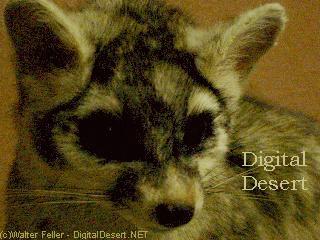Carnivore - Mammal
Ringtail
Bassariscus astutusFamily: Procyonidae Order: Carnivora Class: Mammalia
DISTRIBUTION, ABUNDANCE, AND SEASONALITY
Widely distributed, common to uncommon permanent resident. Occurs in various
riparian habitats,
and in brush stands of most forest and shrub habitats, at low to middle elevations.
Little information available on distribution and relative abundance among habitats (Grinnell et
al. 1937, Schempf and White 1977).
SPECIFIC HABITAT REQUIREMENTS
Feeding: Primarily carnivorous, eating mainly
rodents
(woodrats and mice) and
rabbits.
Also takes substantial amounts of
birds
and eggs,
reptiles,
invertebrates,
fruits, nuts, and some carrion (Taylor 1954, Trapp 1978). Forages on ground, among rocks, in trees; usually
near water.
Cover: Hollow trees, logs, snags, cavities in talus and other rocky areas, and other
recesses are used for cover.
Reproduction: Nests in rock recesses, hollow trees, logs, snags, abandoned burrows, or
woodrat nests.
Water: Usually not found more than 1 km (0.6 mi) from permanent water.
Pattern: Suitable habitat for ringtails consists of a mixture of forest and shrubland in close
association with rocky areas or riparian habitats.
SPECIES LIFE HISTORY
Activity Patterns: Nocturnal; active yearlong.
Seasonal Movements/Migration: Non-migratory.
Home Range: In California, home ranges were estimated to vary from 44-515 ha
(109-1280 ac) (Grinnel et al. 1937). Average home ranges of 20-43 ha (49-106 ac) were
reported for a small number of ringtails in Texas (Toweill and Teer 1981). Also in Texas,
densities of 61 km˛ (16/mi˛) have been reported (Taylor 1954, Toweill and Teer 1981).
Density estimated as high as 10.5 to 20.5/km˛ (27.2 to 53.1 /mi˛) in Central Valley (Belluomin
1980, Poglayen-Neuwall and Toweill 1988).
Territory: No information found. In Texas, home ranges of females were separated
widely; home ranges of males overlapped those of females (Toweill and Teer 1981).
Reproduction: Young reportedly often born in May and June (Walker et al. 1968). One
litter/yr; average of 3 young, range 1-5. Gestation from 40-50 days. Females may drive
males away 3-4 days prior to giving birth.
Niche: Probable
predators
include
bobcats,
raccoons, foxes, and especially
large owls.
Trapp (1972) discussed the ringtail's adaptation to rough, broken terrain, including naked
soles of feet providing traction on smooth surfaces, ability to rotate hindfeet in half circle
dexterous forefeet with limited opposability of first 2 digits, and numerous behavioral
adaptations. Potential competition for food exists between ringtails and many sympatric
species (e.g., raccoons, gray foxes,
coyotes,
barn owls,
great horned owls,
rattlesnakes,
gopher snakes).
Source:
CDFW California Wildlife Habitat Relationships. Accessed [N/A]
https://wildlife.ca.gov/Data/CWHR

Ringtail Cat
A cat-sized carnivore resembling a small fox with a long raccoon-like ringed tail. The long tail helps them to balance allowing them to climb nearly vertical faces in the rocky terrain they prefer.
The ringtail is buff to dark brown in color with white underparts and a well defined black and white striped tail which is longer than the rest of its body. The eyes are large and black, each surrounded by a patch of light fur. Slightly smaller than a housecat, the ringtail measures 12-18 inches long with a tail of 12-18 inches, and weighs 1-1/2 to 2-1/2 lbs. The ringtail's lifespan in the wild is about seven years.
Ringtails eat a wide variety of foods; rats, mice, squirrels, cottontails, including carrion; snakes and lizards; insects, mostly grasshoppers and crickets; spiders, and scorpions; and fruits of native plants.
Also see > Mammal: Carnivore: Predator: Nocturnal
MAMMALS
Predators
Mountain Lion
Coyote
Bobcat
Kit Fox
Badger
Ringtail Cat
Prey
Desert Bighorn Sheep
Desert Cottontail
Jackrabbit
Antelope Squirrel
Other
Mustang
Wild Burro
REPTILES
BIRDS
INSECTS